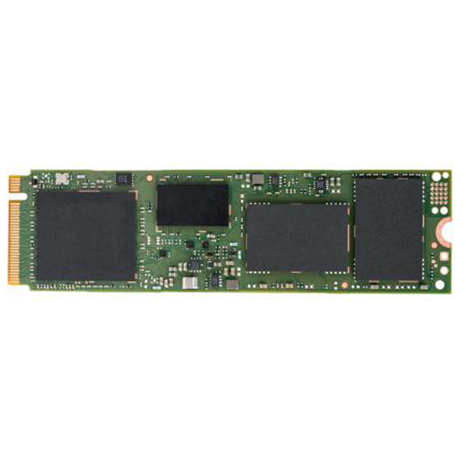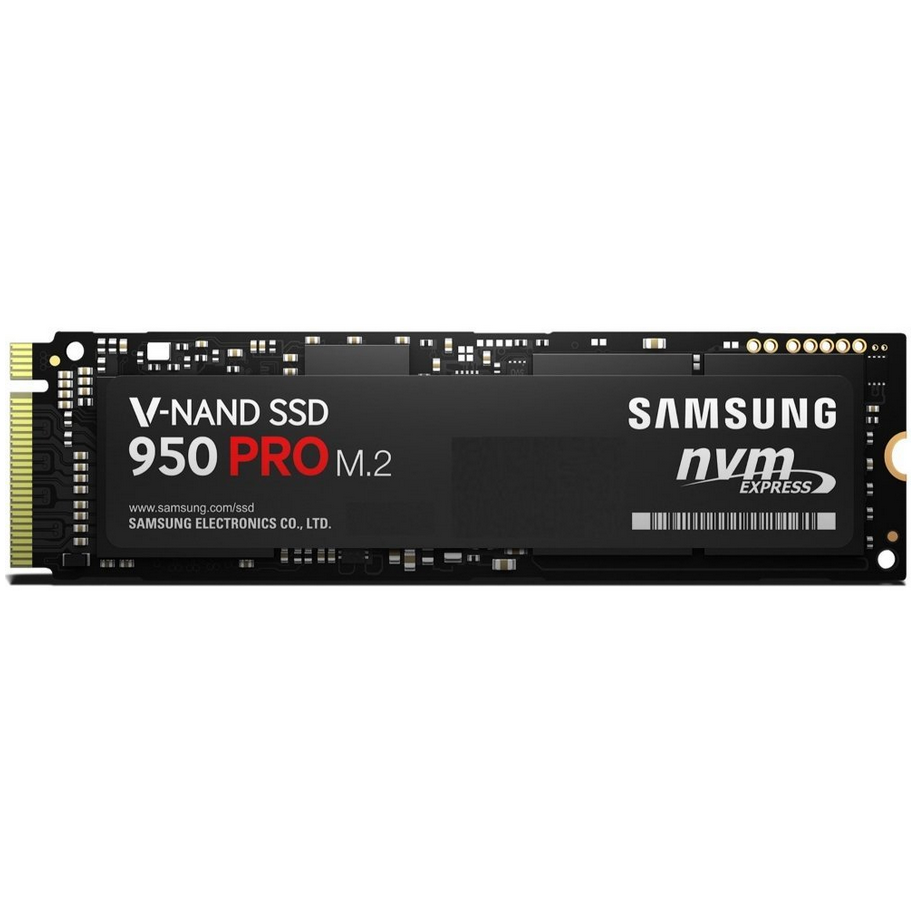Patriot Hellfire M.2 240GB NVMe SSD Review
Why you can trust Tom's Hardware
Comparisons And Benchmarks
Comparison Products
We removed all of the high capacity, ultra-performance NVMe SSDs to focus on the smaller and least-expensive products. The Samsung PM961 is the stand-in for the upcoming 960 EVO, which is sure to be the drive to beat in both performance and price. We only have the PM961 512GB so that will serve as the comparison product for the Hellfire M.2 480GB with the new 2.1 firmware. We also included the Hellfire M.2 480GB with the obsolete firmware to illustrate how the new firmware improves performance. We also present the Intel 600p 512GB as a comparison product just to cover all of the bases.
The Hellfire M.2 240GB is the main focus of our analysis. We compare the drive to the Intel 600p and Samsung 950 Pro 256GB, which addresses the premium and entry-level NVMe segment.
Sequential Read Performance
To read about our storage tests in-depth, please check out How We Test HDDs And SSDs. Four-corner testing is covered on page six of our How We Test guide.
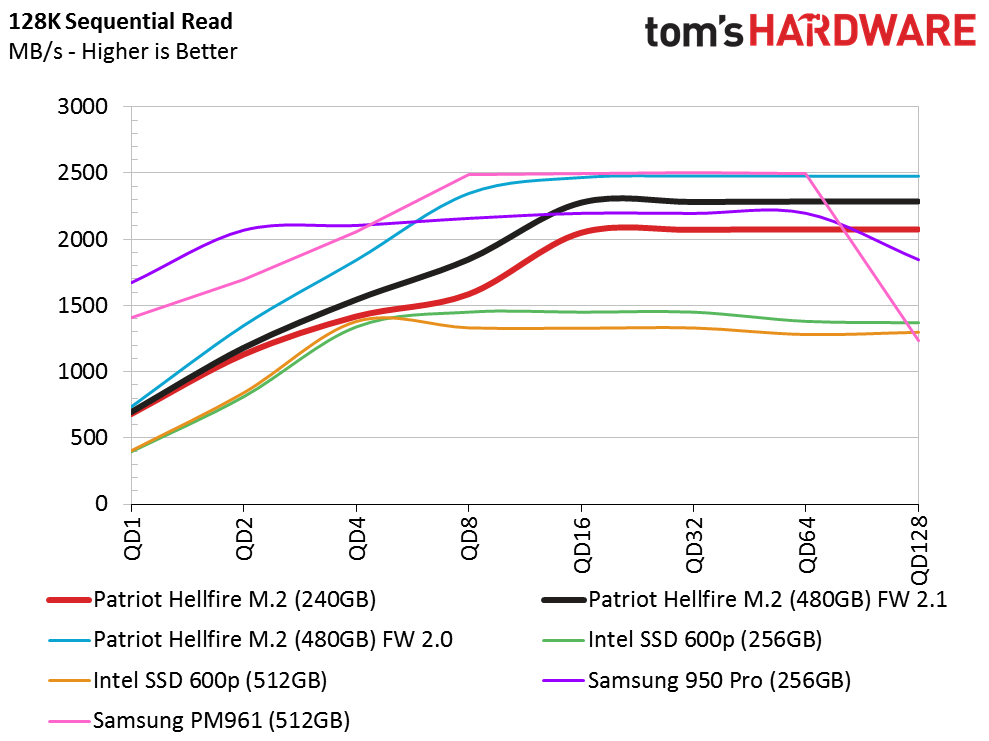

The first thing you will notice in all of the synthetic tests is the Hellfire’s lower performance compared to the Hellfire M.2 480GB's original firmware. In the latter portion of the testing phase, we will notice that Phison offset the performance drop in synthetic workloads with improvements to real-world application
For this review, we really want to focus on the Hellfire M.2 240GB and how it compares to the Intel 600p 256GB ($99) and Samsung 960 EVO 250GB ($129). The Hellfire's price will need to slot right between these two products, or the SSD will have to outperform them both across the board. We don't expect our 960 EVO samples to arrive for another couple of weeks, but if the Hellfire M.2 240GB can outperform the PM961 512GB, it's certainly a step in the right direction.
All three Hellfire M.2 drives deliver nearly identical queue depth 1 sequential read performance at 700 MB/s. At QD2, the performance shoots up to over 1100 MB/s.
Sequential Write Performance
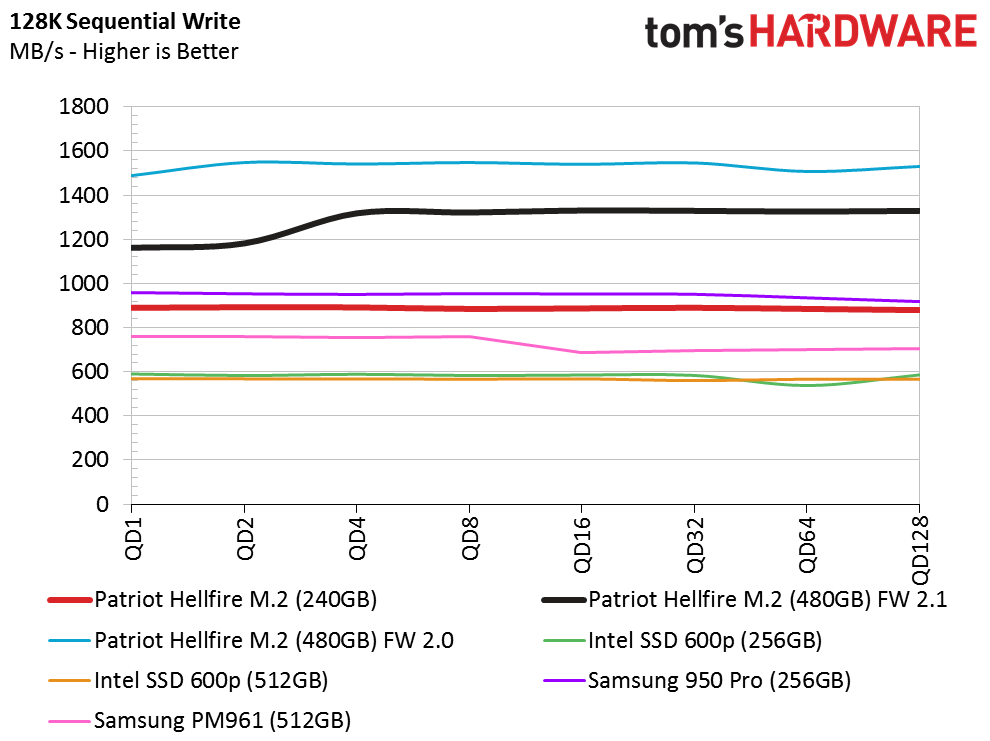
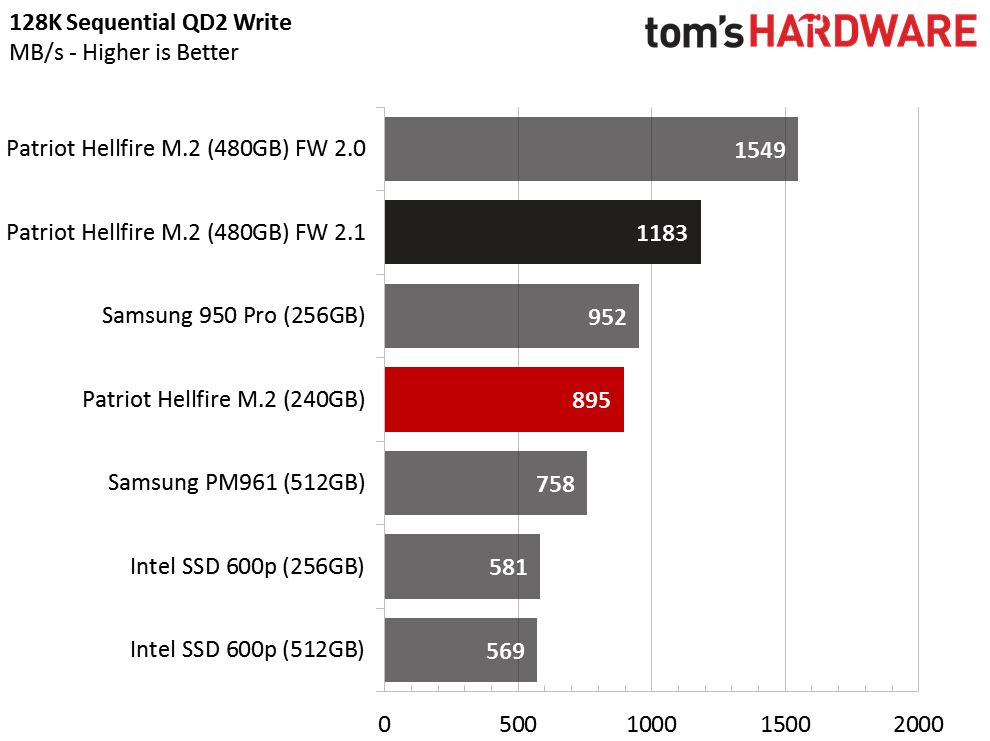
The Hellfire M.2 480GB with the original 2.0 firmware was the king of sequential write performance among the new low-cost NVMe SSDs. The new firmware tones down sequential performance a bit, and there is also a large gap between the 480GB and 240GB SSDs. The 240GB outperforms the Samsung PM961, and Intel's 600p nips at the heels of the premium Samsung 950 Pro 256GB.
Get Tom's Hardware's best news and in-depth reviews, straight to your inbox.
Random Read Performance
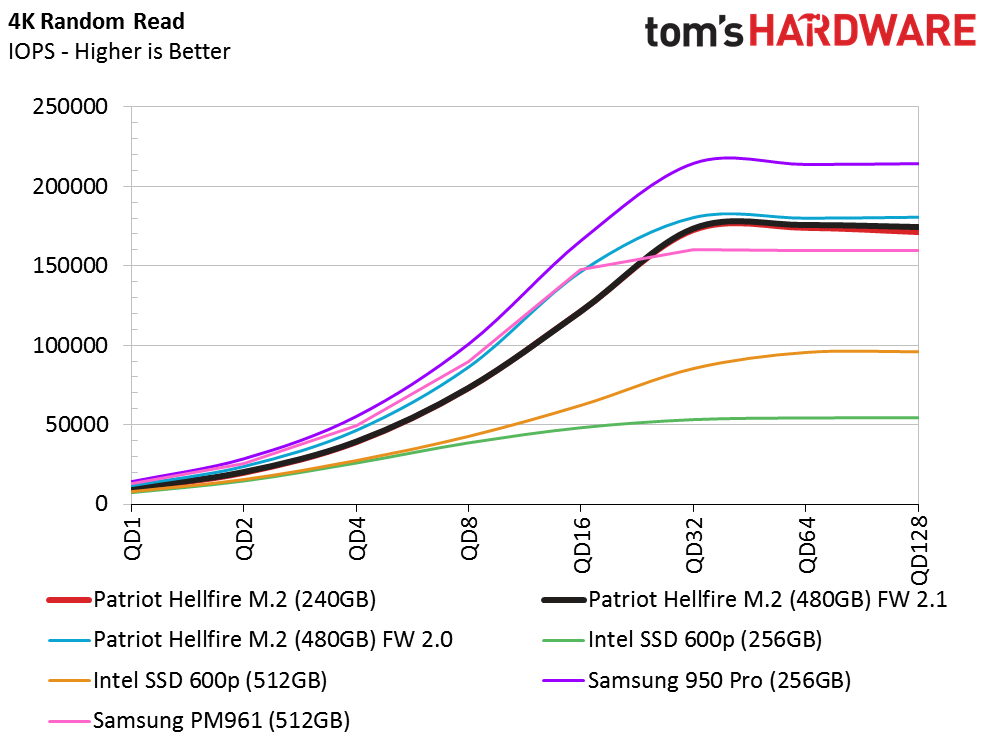
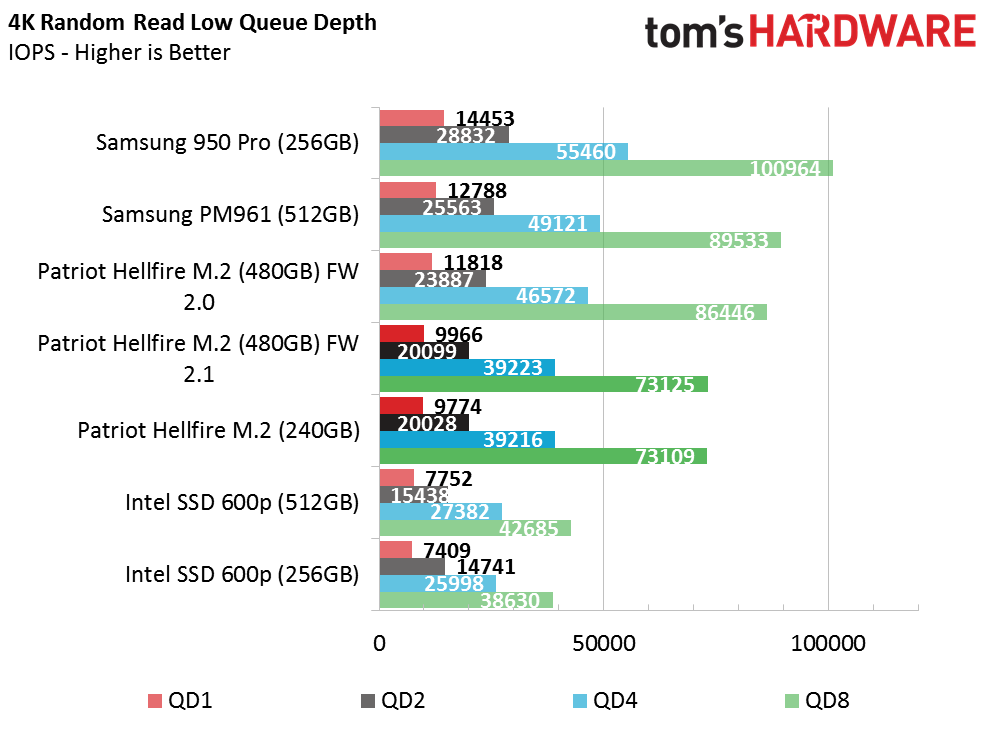
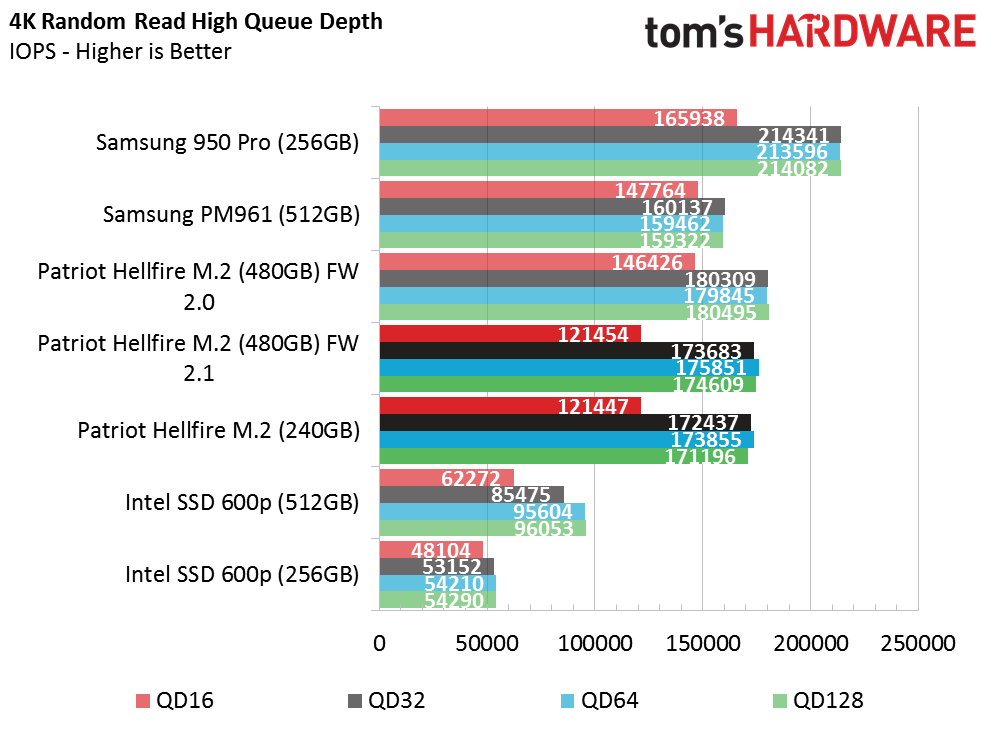
Our biggest complaint about Phison controllers is the comparatively slow random read performance. No matter what tweaks Phison implements, the company just can't achieve high numbers in this important measurement. The new 2.1 firmware actually drops the QD1 reads to less than 10,000 IOPS, a mark that Samsung and others are capable of with premium and some mainstream SATA SSDs. We're disappointed in the regression here.
Random Write Performance
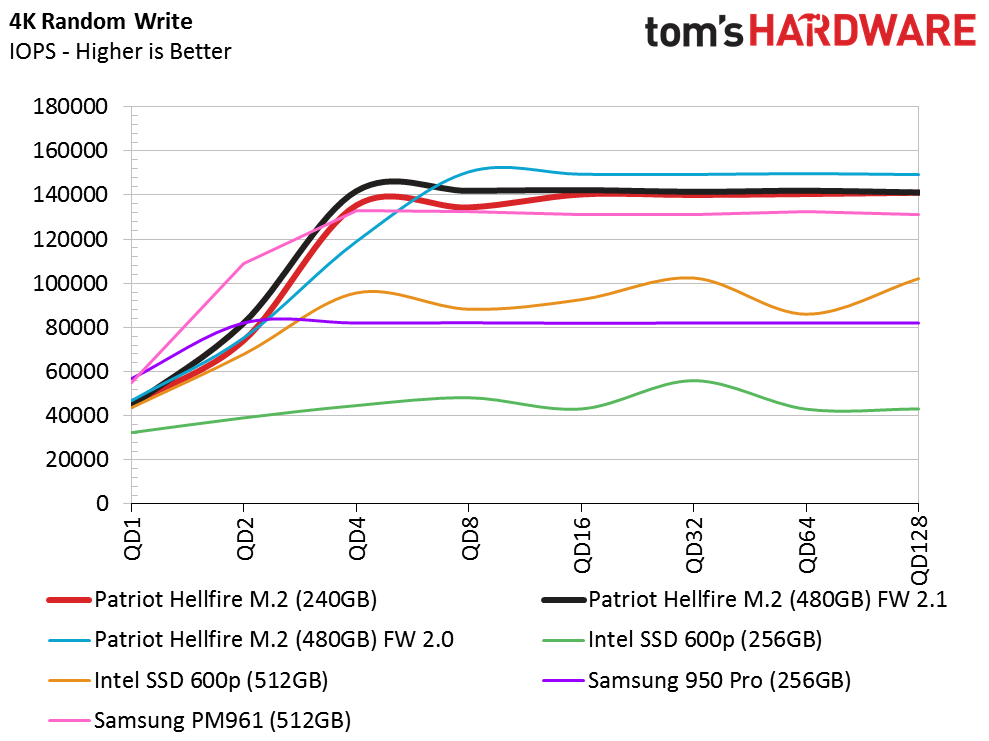

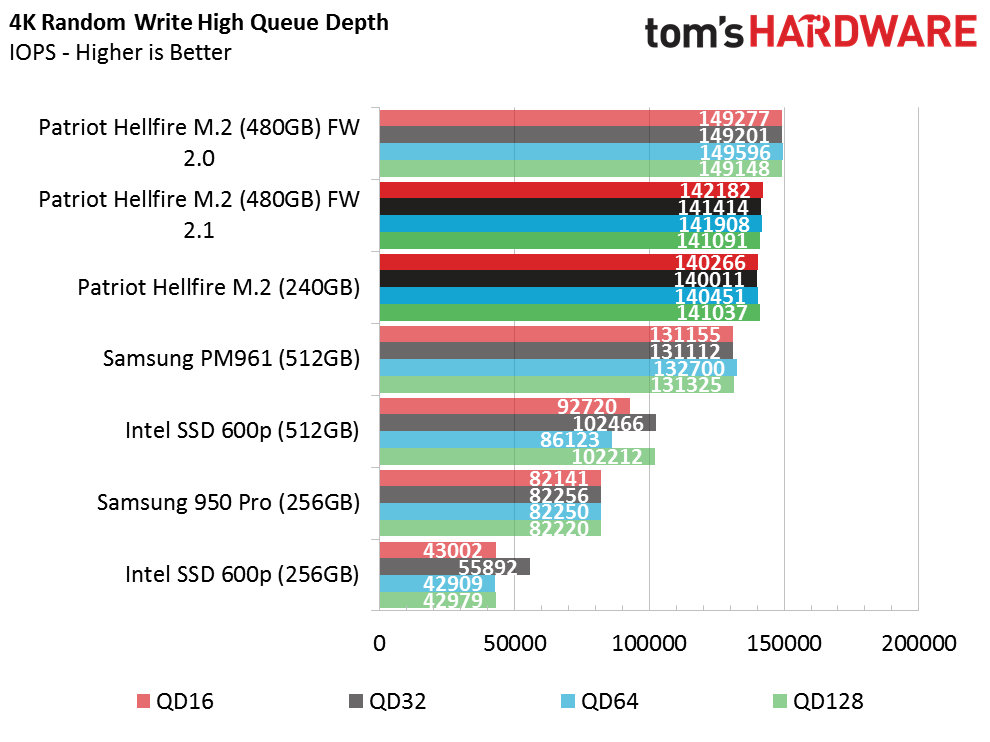
We like the 4KB random write performance curve from both of the Hellfire drives with the new firmware. The drives show strong performance at QD4, which is the maximum we need to concern ourselves with for heavy consumer workloads.
80 Percent Mixed Sequential Workload
We describe our mixed workload testing in detail here, and describe our steady state tests here.

The mixed sequential performance really dropped off with the new firmware. The older firmware produced one of the highest results we've seen. The new firmware reels the performance in, but we'll have to see how the application performance compares later in this review before judging the drives.
80 Percent Mixed Random Workload
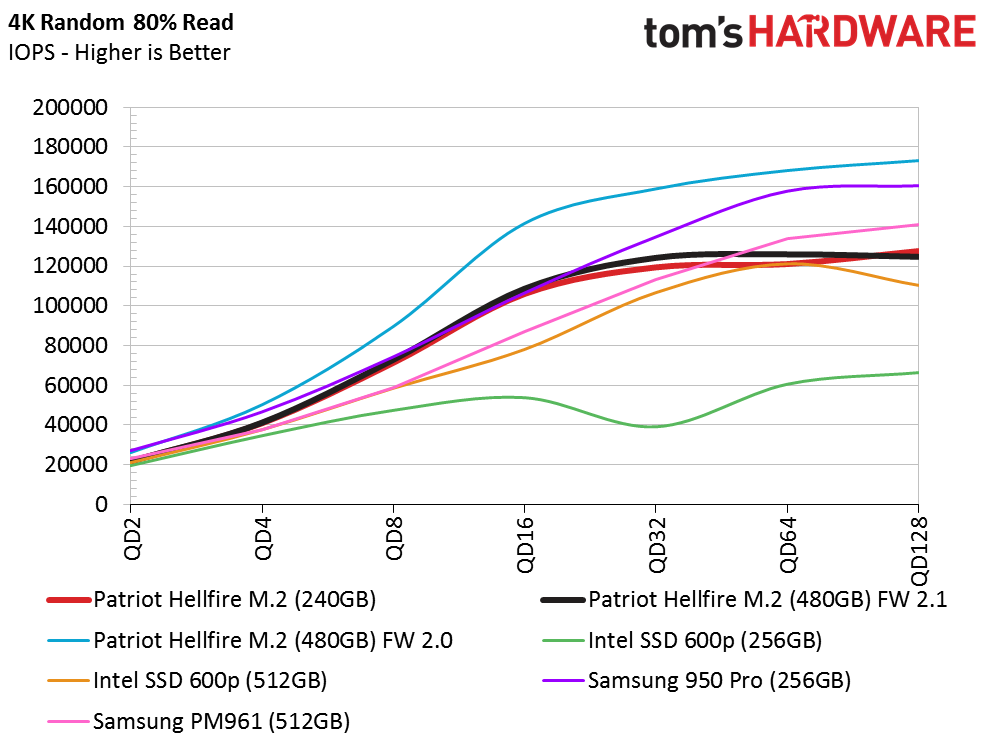
The mixed random test also reveals a wide gap between the pre- and post-firmware update. It's easy to get carried away with that aspect of the review. The 256GB drive compares really well to the 950 Pro, and it obliterates the Intel 600p 256GB.
Sequential Steady-State
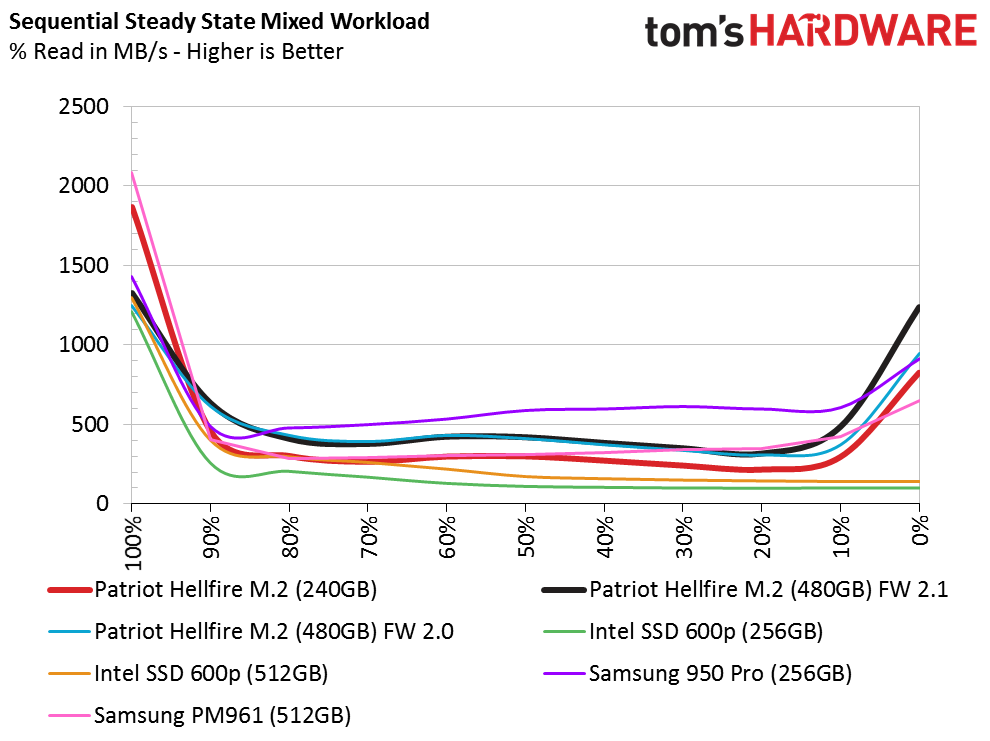
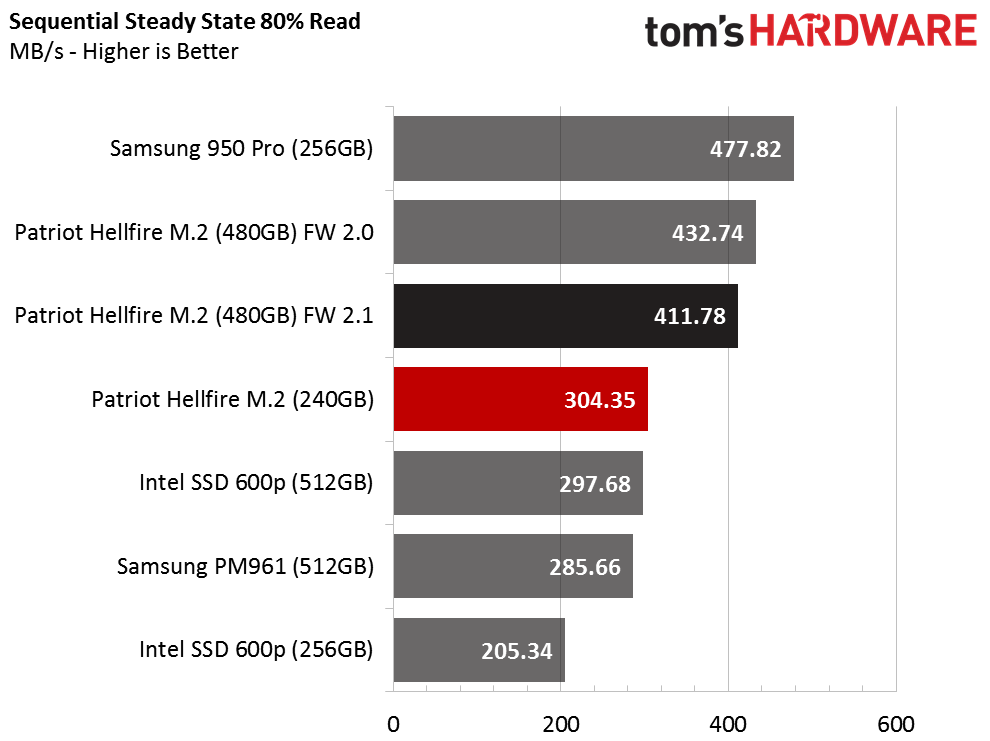
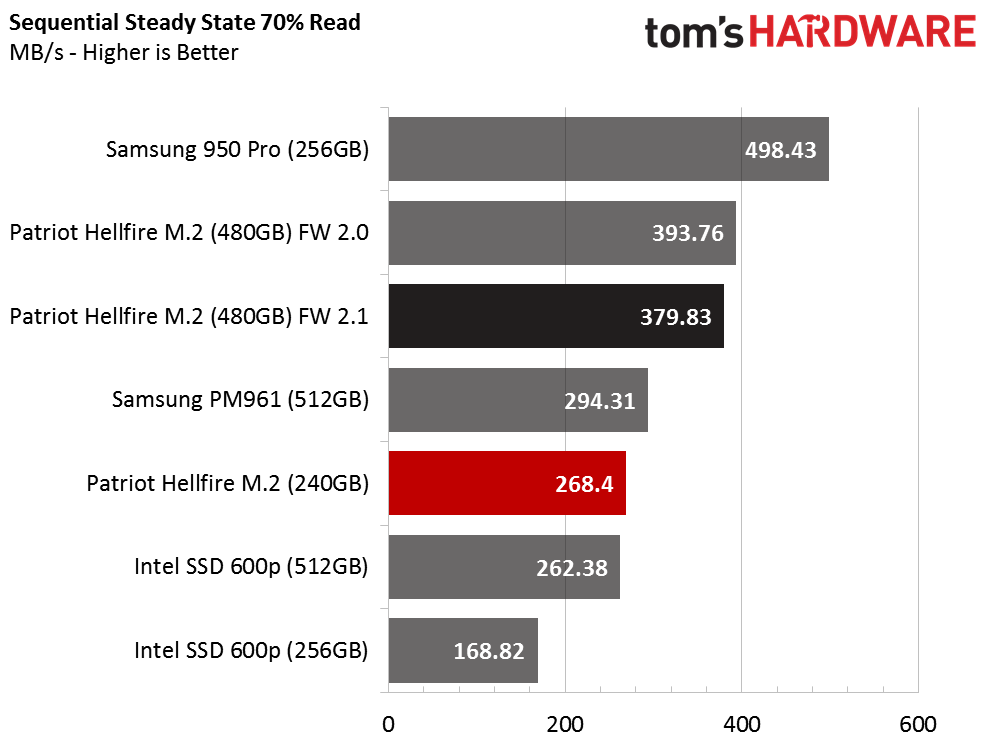
MLC usually outperforms TLC when you push an SSD hard. The NVMe protocol running over PCI Express allows the flash to perform without interface limits--but steady state is an entirely different ballgame. Under these conditions, the controller is struggling to keep pace with the workload. The background activity is churning away to manage the cells and trashing the flash with data in every available cell.
It shouldn't come as a surprise that the 950 Pro 256GB outperforms every other drive in the charts; this is the kind of workload Samsung built the Pro products for. The Patriot Hellfire M.2 drives hold their own, though. The 480GB outperforms the PM961, and the 240GB model outperforms both of the Intel 600p NVMe SSDs.
Random Steady-State
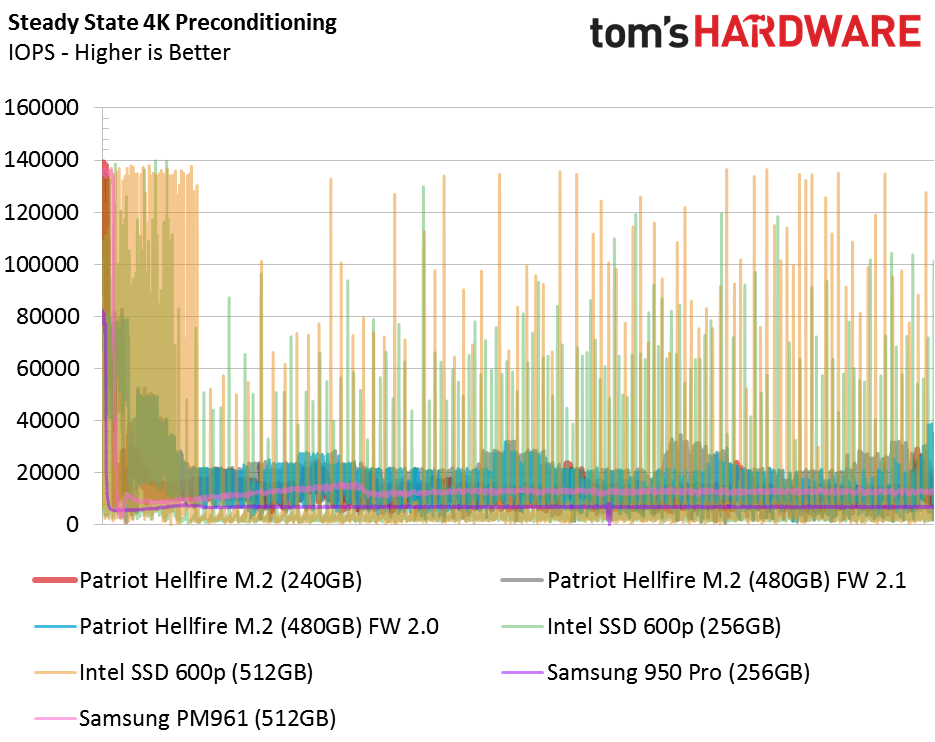

The Hellfire drives don't deliver consistent performance, but they do deliver a high steady-state average compared to the other products in the chart. Some users will want to build a RAID array with this series to increase performance further. The drives are not ideal for RAID 0 on the Intel PCH but should yield better results than a single drive. Part of the performance problem comes from Phison's lack of a custom NVMe driver. Moving over to the Intel RAID driver won't degrade performance at low queue depths.
PCMark 8 Real-World Software Performance
For details on our real-world software performance testing, please click here.
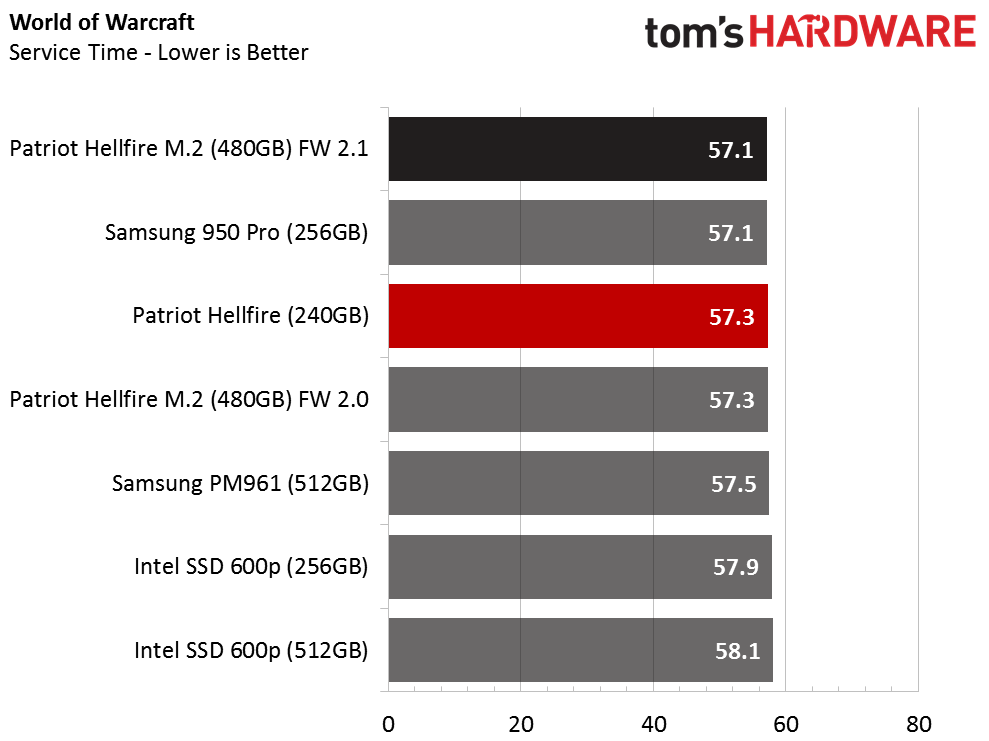
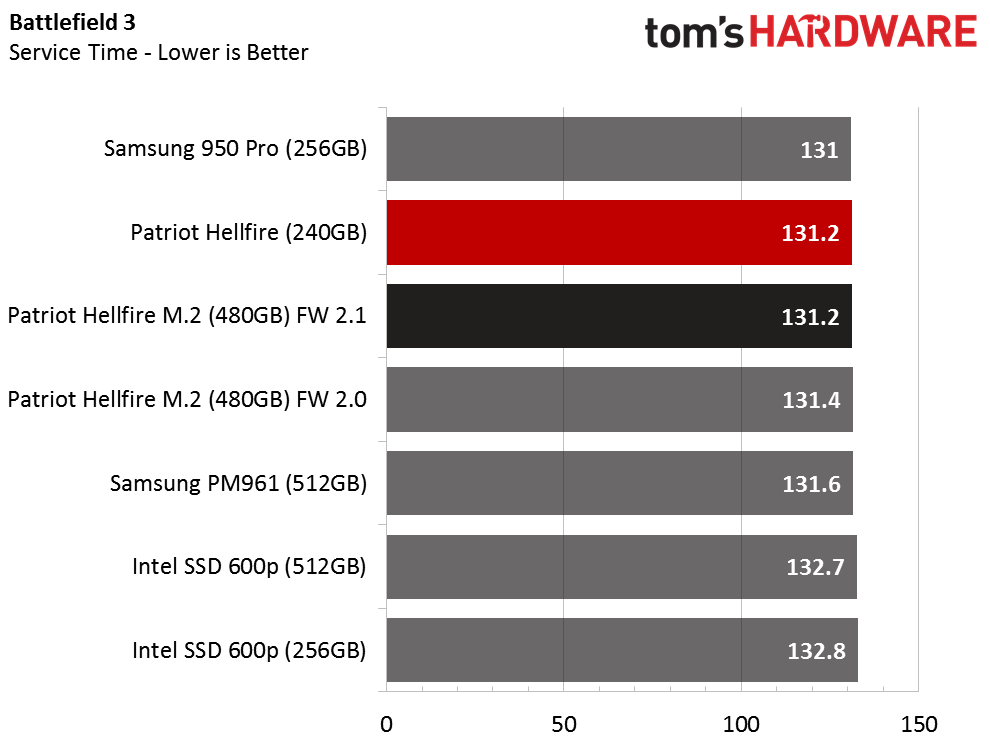
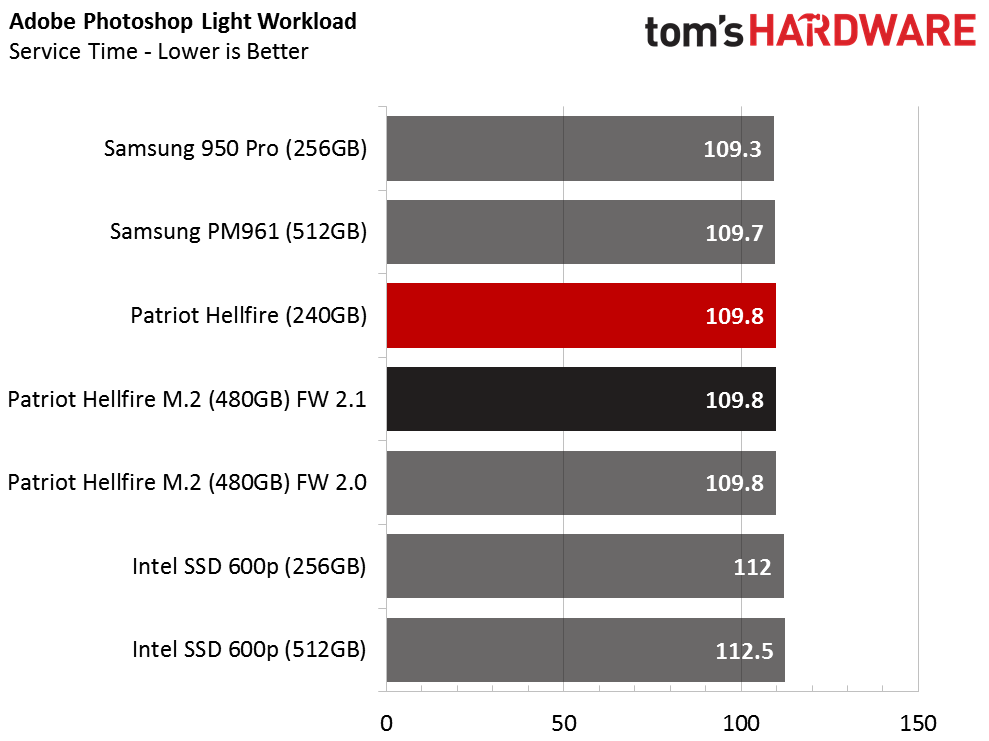
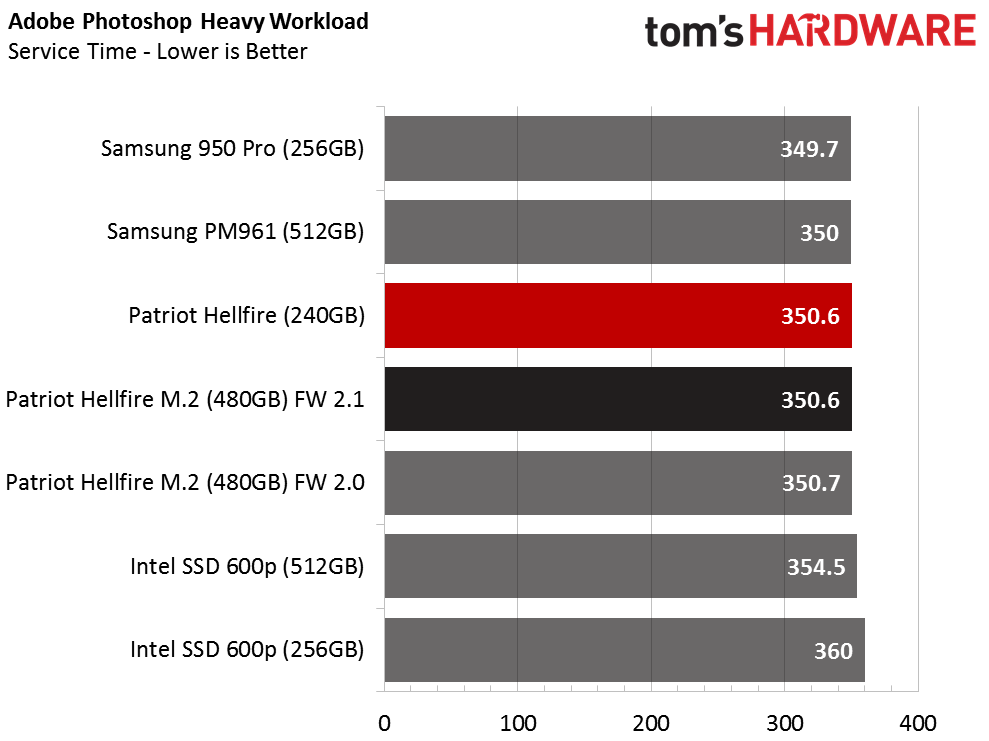
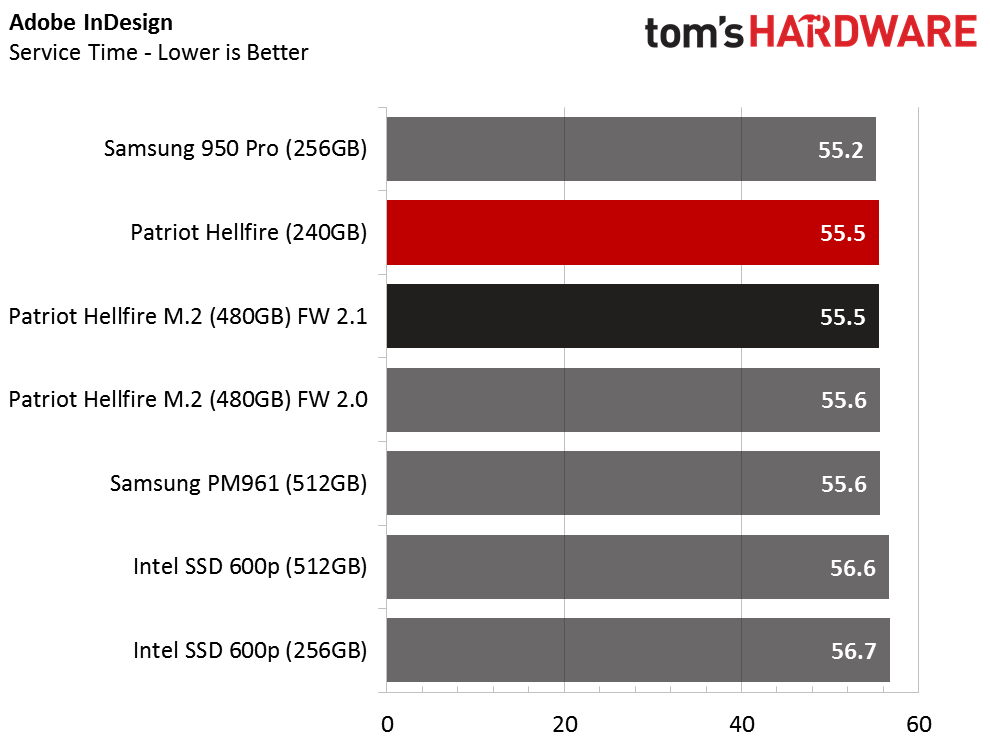
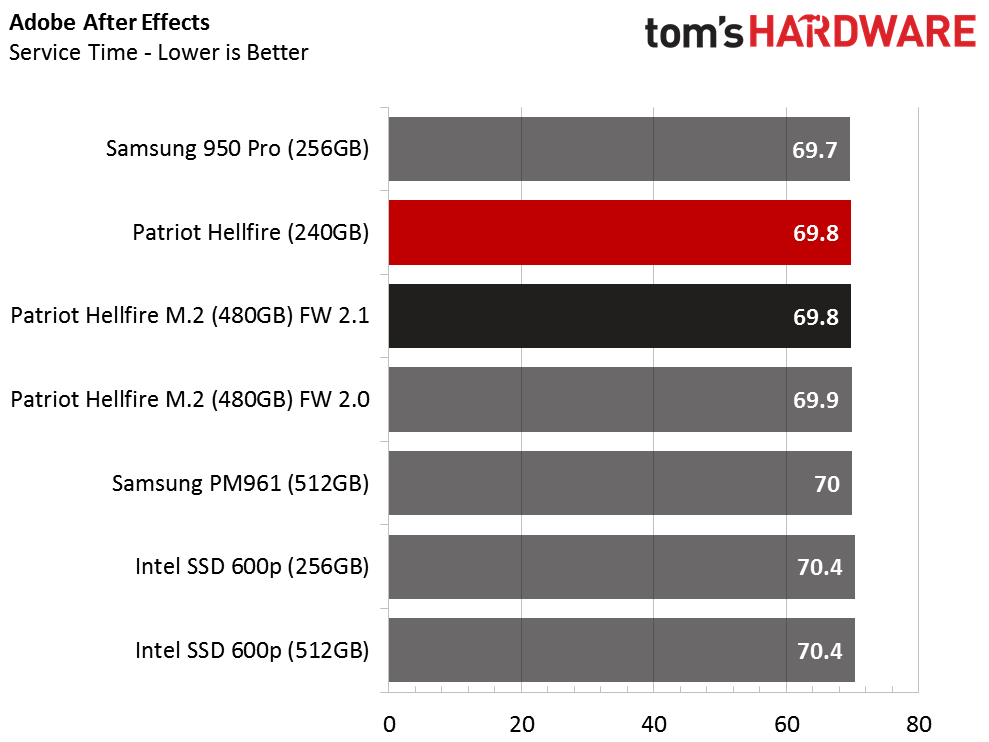
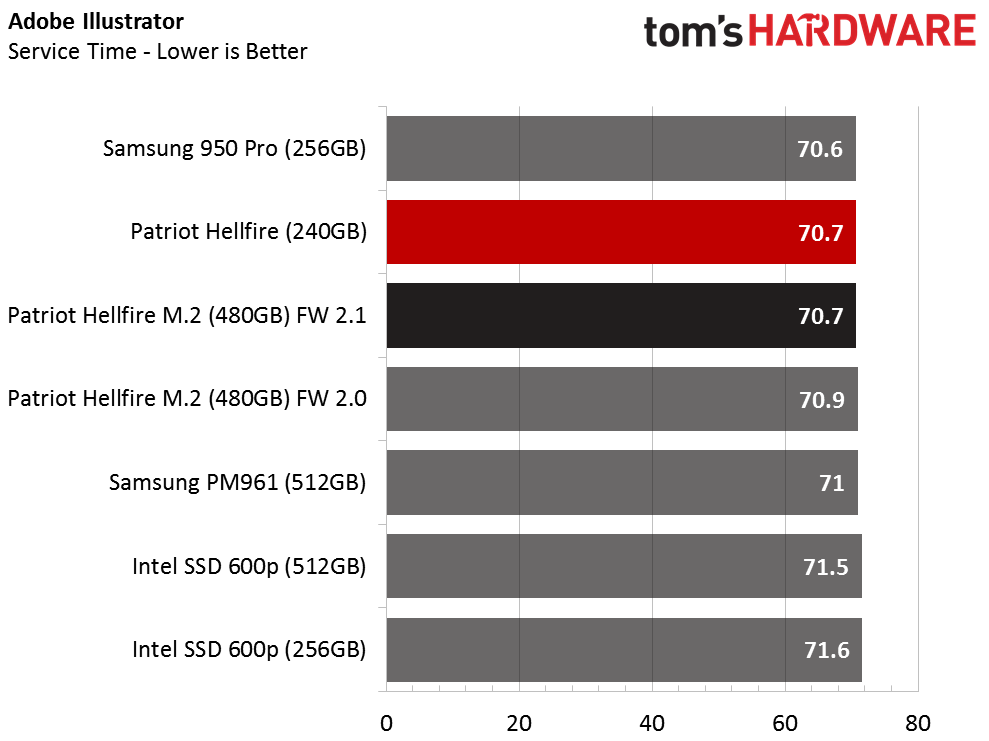
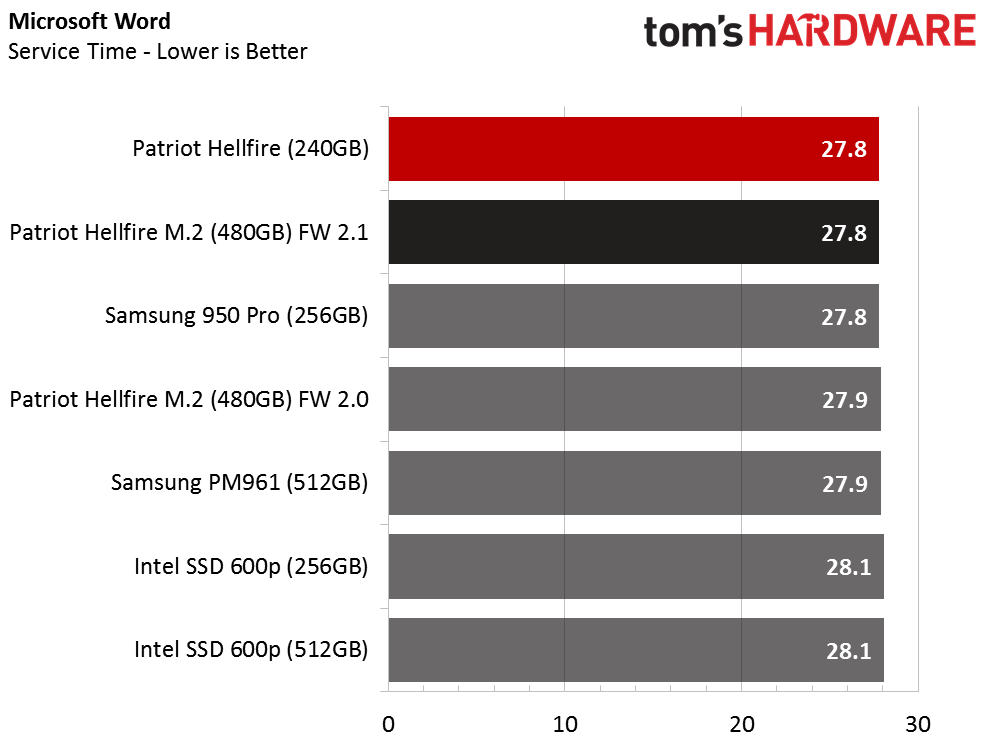
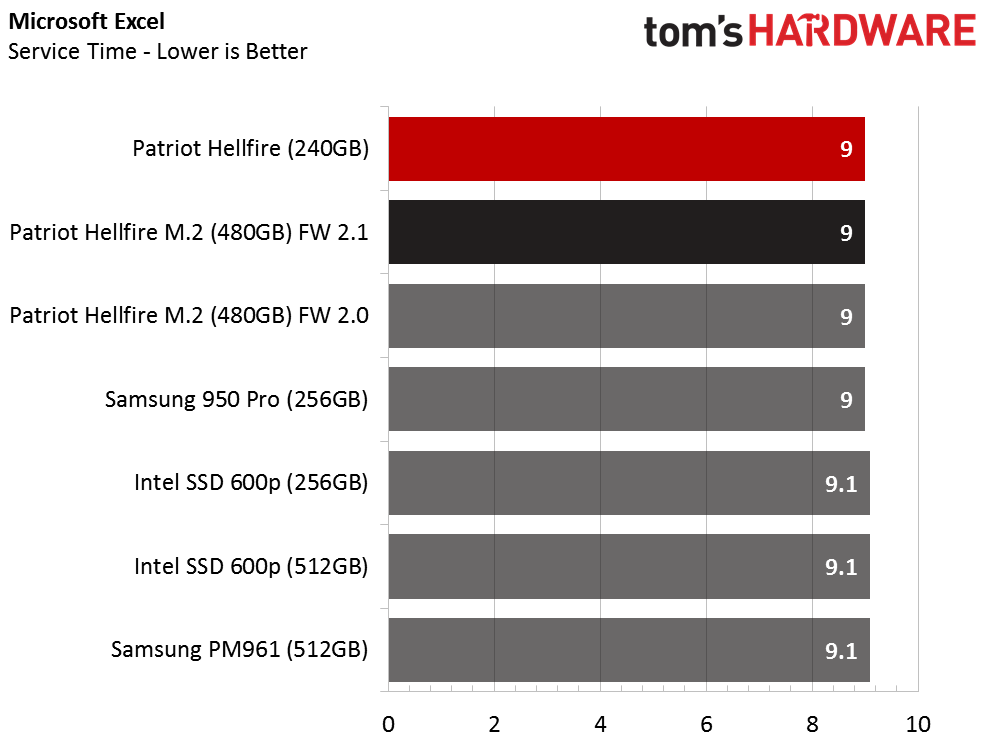
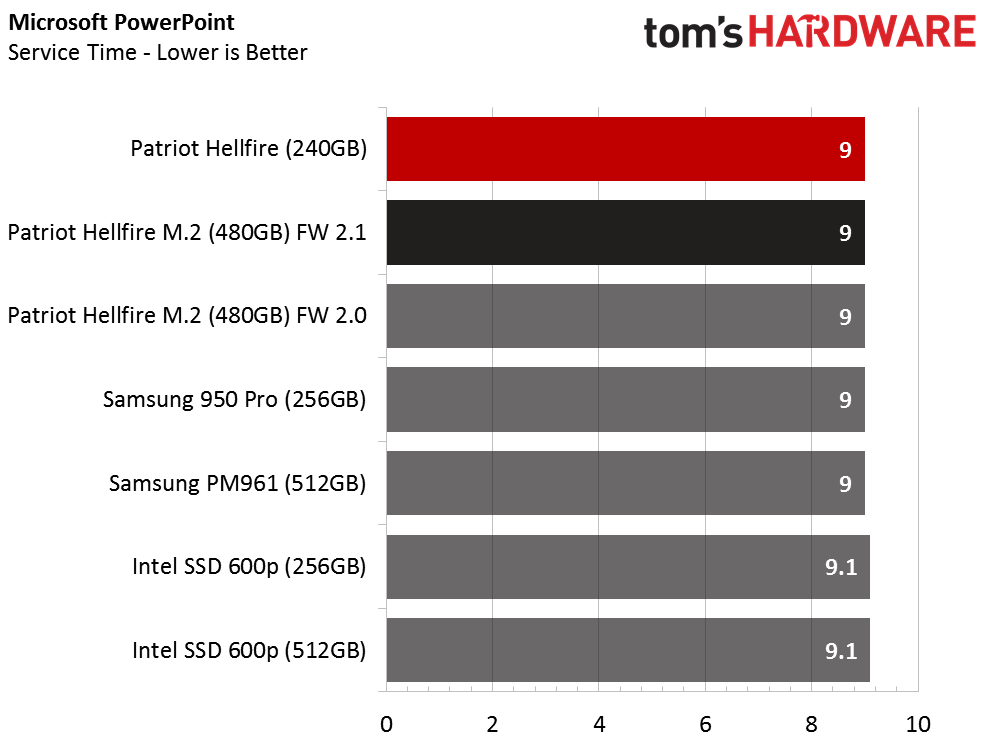
As we mentioned, the new firmware update gives the Hellfire teeth in real world applications. The fruits of Phison's labor shine through here. In all but two of the applications, the Hellfire M.2 outperforms the other products in the same entry-level and mainstream classes. In many of the tests, the Hellfire SSDs even perform the same as the Samsung 950 Pro.
Application Storage Bandwidth
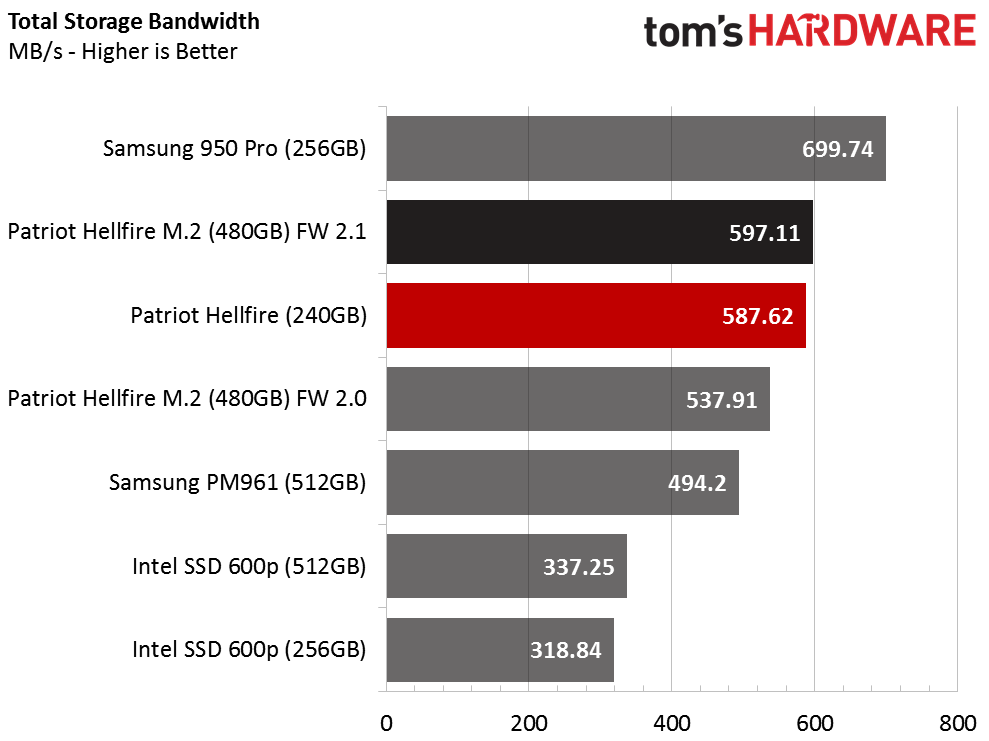
This is the kind of performance we've expected out of the Phison PS5007-E7 controller since it debuted over two years ago. We think Phison can get a little more out of the 8-core design with more tuning. There will be some additional updates later to fill in some gaps. We'll cover that later in the review.
PCMark 8 Advanced Workload Performance
To learn how we test advanced workload performance, please click here.
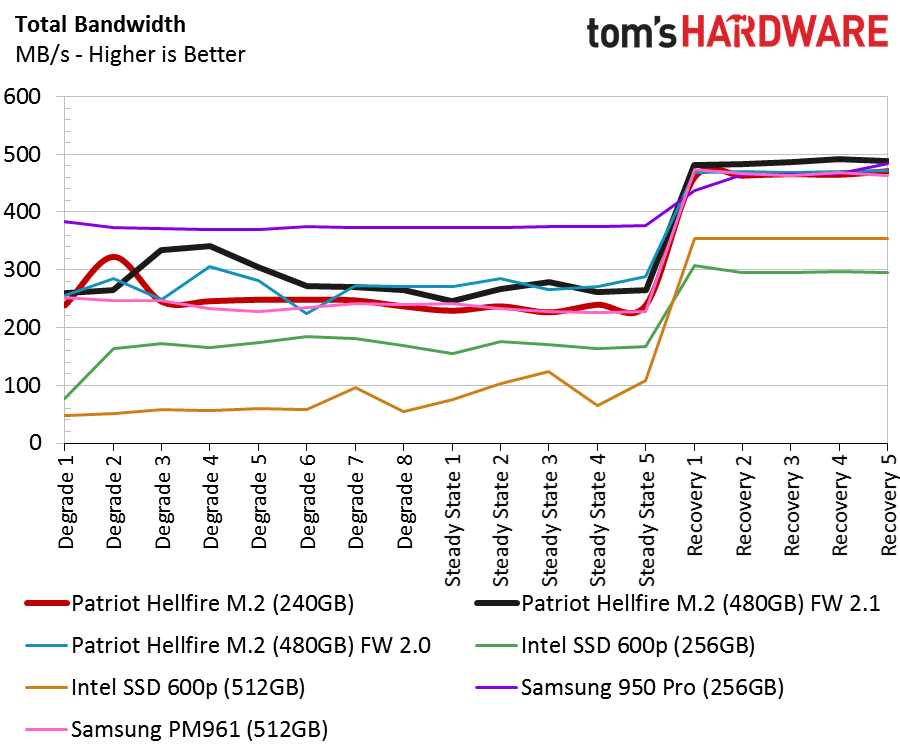

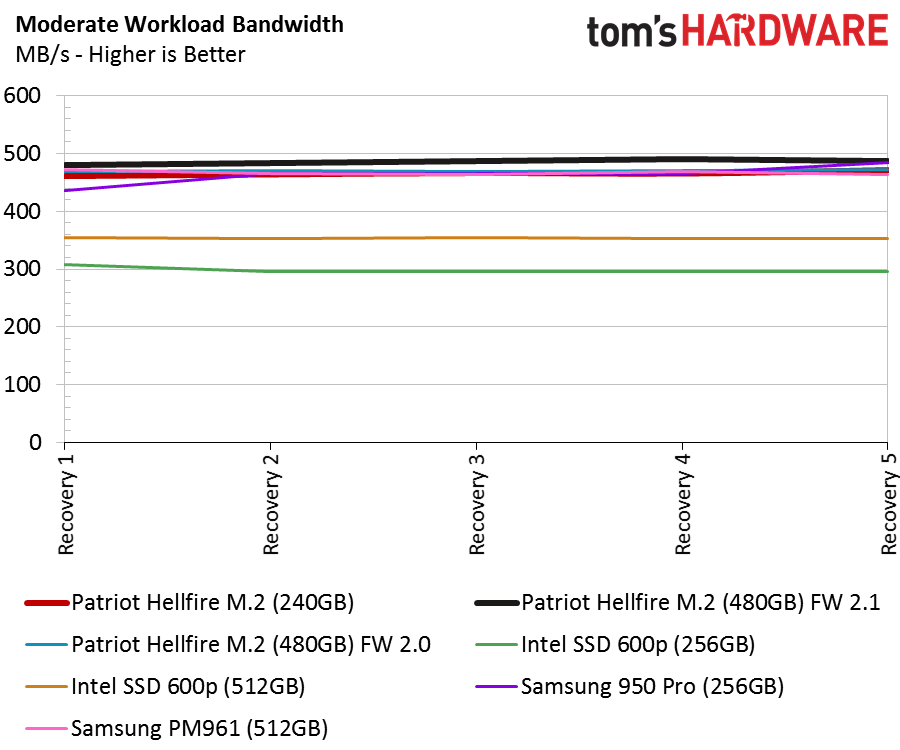
Patriot points the Hellfire at mainstream users, so we'll focus exclusively on the recovery portion of the tests. Patriot serves the gaming market, and most of those users install a lot of software early in the SSD's life. After that, the software updates come, but data is written in large bursts followed by long periods of idle or read-only time. Futuremark specifically targets this type of condition with the recovery phase of its PCMark 8 storage test.
The Hellfire M.2 SSDs top the charts and fall into the same cluster as the two Samsung SSDs. The two Intel 600p products struggle to keep pace and are not in the same performance league as the Hellfire M.2 SSDs.
Total Service Time
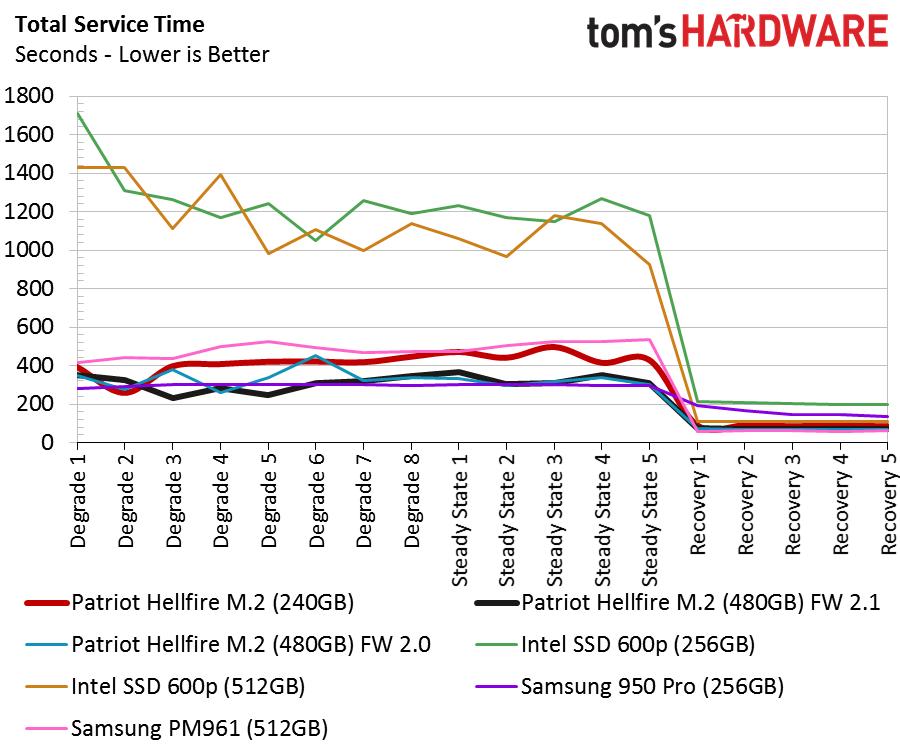
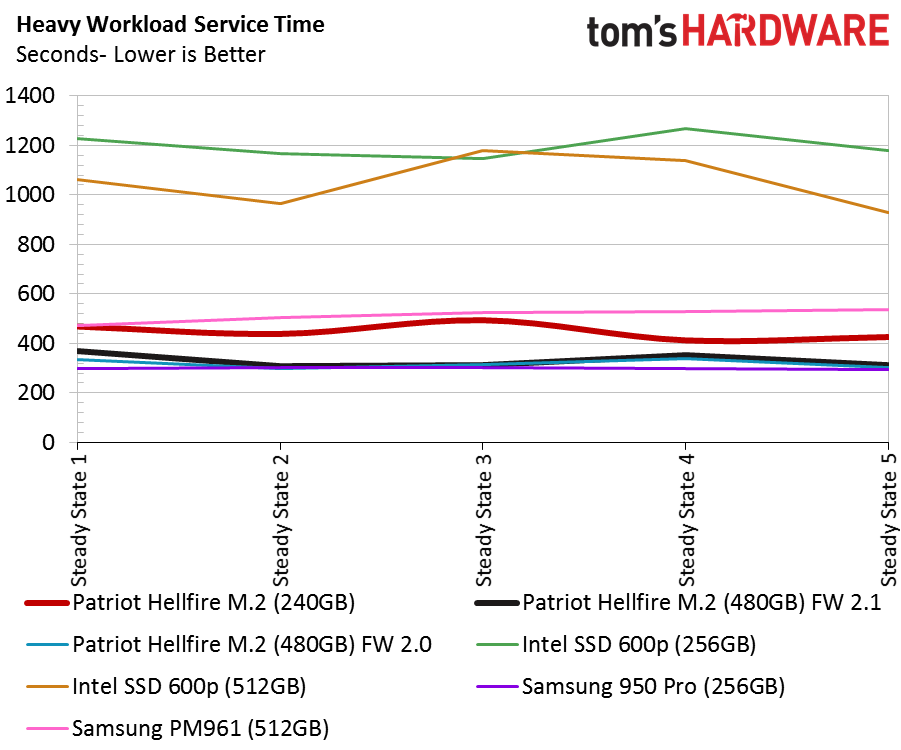
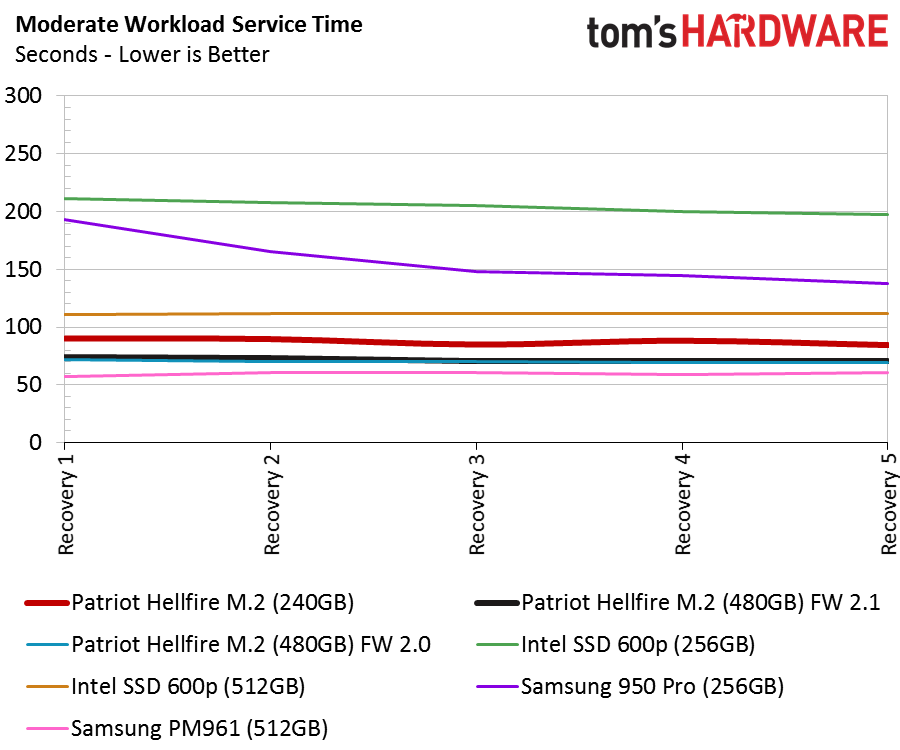
The service time tests look really good, as well. The 960 EVO performs slightly better, but the Hellfire drives follow close behind. They also outperform the 950 Pro 256GB.
Disk Busy Time
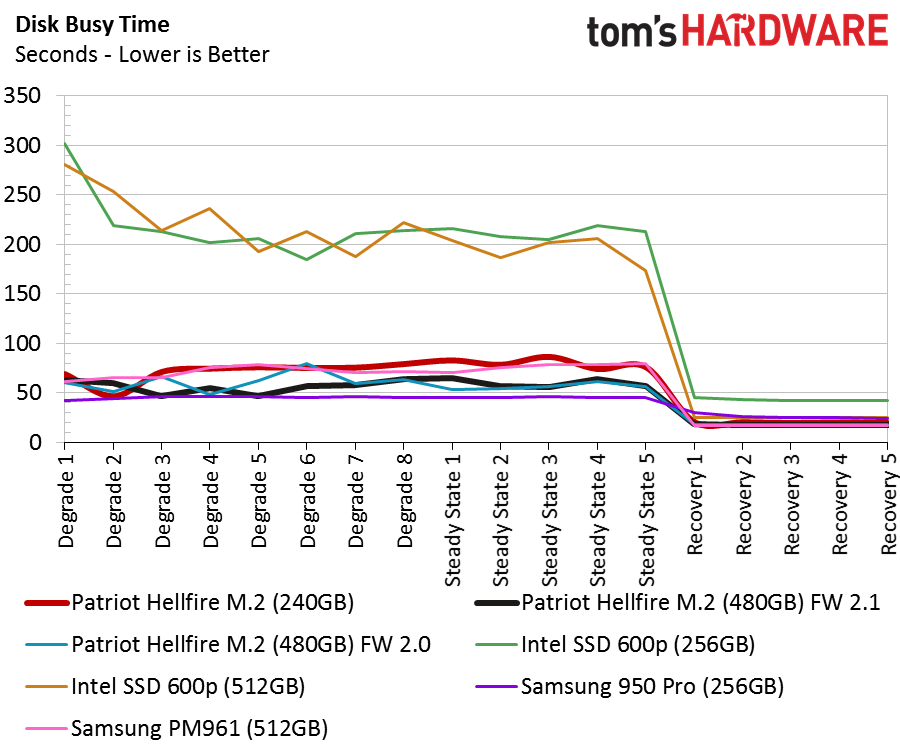
We use the disk busy time measurement to understand the notebook battery-life test that follows. For the Hellfire, the "working" and return-to-idle time has little to do with the battery performance.
Notebook Battery Life
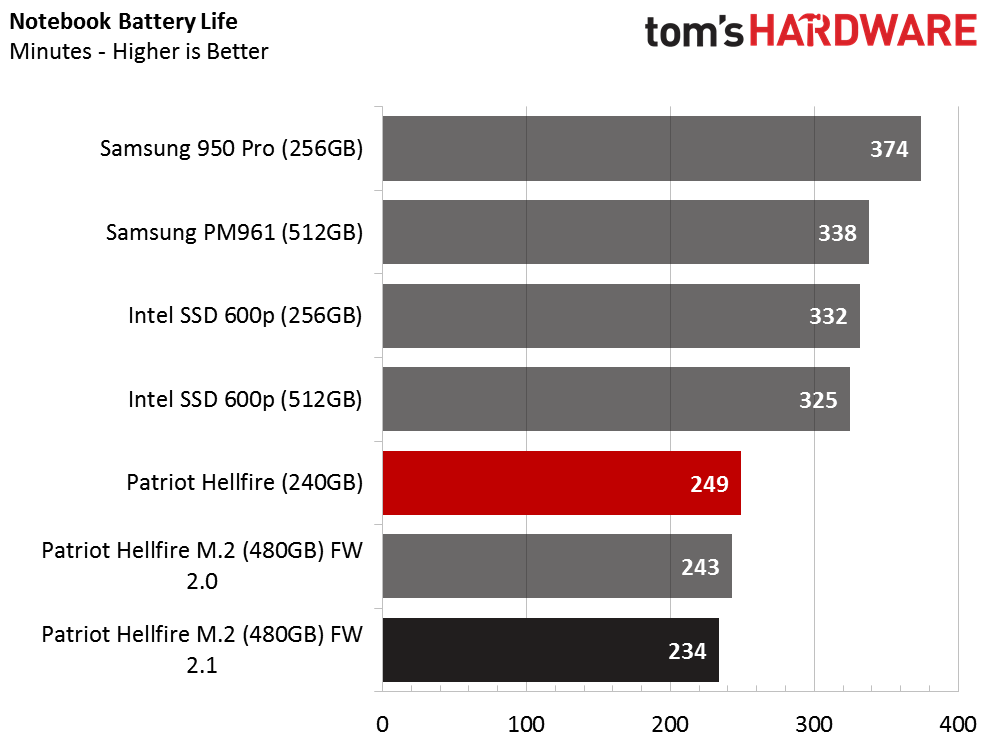

Phison hasn’t optimized the PS5007-E7 for mobile use yet. Patriot is aware of the issue and plans to address it later with an optimized firmware. After the first review with the Hellfire 480GB running 2.0 firmware, the company stated it designed this series for gamers looking to update desktop systems, and not for business use in notebooks.

Chris Ramseyer was a senior contributing editor for Tom's Hardware. He tested and reviewed consumer storage.
-
Game256 "The Hellfire M.2 is currently the only NVMe SSD to target the middle, but that will change next month when Samsung ships the 960 EVO to resellers"Reply
The release date of Samsung 960 EVO/PRO is October. Or you know "something"? -
Game256 Another meaningless and overpriced drive. The only thing that may help all these vendors to compete with Samsung is the price but usually they constantly overstate it, making it too close to Samsung 950 Pro. Samsung is going to kill them all with 960 EVO.Reply -
Game256 Btw some Polish and German tech sites already received samples of Samsung 960 Pro so it's interesting that you didn't received them yet.Reply
https://scontent-waw1-1.xx.fbcdn.net/v/t1.0-0/s480x480/14729397_2937997012914136_7324007564864990086_n.jpg?oh=e0996b629cf74e7be362bd42809d54f2&oe=58AA4E34
https://scontent-waw1-1.xx.fbcdn.net/t31.0-8/14612499_10154535560642207_9118950000337195147_o.jpg -
Brian_R170 "The Patriot Hellfire M.2 and Intel 600p are the first products to really burst the NVMe pricing bubble." Are you speculating on future pricing? The statement is hardly true based on actual retail or suggested retail pricing. I checked the retail pricing of currently-available M.2 NVMe SSDs and all but 2 cluster together with pricing differences of less than 10%. The outliers are the Intel 600p and the Plextor M8Pe.Reply -
shrapnel_indie I guess bursting the bubble depends on the source of your part: At the beginning of the article, the viewed pricing on my end was more in competition to Samsung's M.2 PCIe offerings a few months ago. At the end of the article, it was more in-line for the mid-range to high-range SATA drives of comparable size.Reply -
JustAnITGuy PLEASE ALWAYS include a standard 7200RPM 3.5" drive and a 7200RPM 2.5" drive with ANY SSD benchmarks. The vast majority of people still have these old drives, and if this is to educate people to purchase products, It would be nice to see a side-by-side comparison and not have to go to separate benchmark articles or websites.Reply -
CRamseyer The results are so much different we can't really put them in the same chart together. Maybe in the future we will publish an article with a mainstream HDD, SSD and NVMe SSD for a comparison.Reply -
steve4king "It turns out the Patriot Hellfire M.2 is not the product we originally thought it was. After some tuning, the application performance is up and this drive is ready to take on the emerging mainstream NVMe market."Reply
What do you mean? The product you originally thought it was was based on the original firmware.. right? The 2.1 firmware is about the same, or noticeably worse than the 2.0 firmware in every bench.. -
steve4king Under sequential read performance, I think you have a typo:Reply
"The 240GB outperforms the Samsung PM961, and Intel's 600p nips at the heels of the premium Samsung 950 Pro 256GB."
I think you meant to say:
The 240GB outperforms the Samsung PM961 and Intel's 600p, and nips at the heels of the premium Samsung 950 Pro 256GB.

